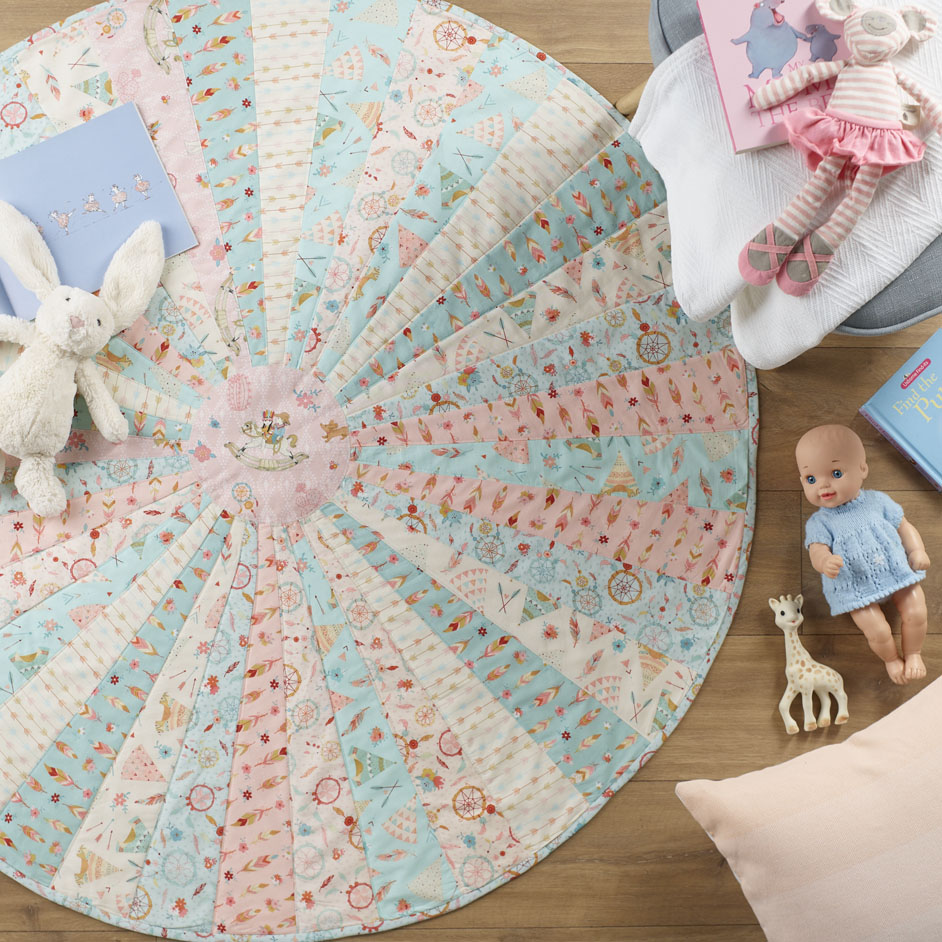 | ||
| Your browser is not supported. | ||
|
Please browse our site using any of the following options:
| ||
FOREVER FRIENDS CIRCLE QUILT

LEVEL: INTERMEDIATE
WHAT YOU'LL NEED
INSTRUCTIONS
Using a wedge ruler cut out fabrics for quilt top. We used 6 fabrics and a 10 degree wedge ruler so had 6 wedges from each colour and a total of 36 wedges. If you used a 20 degree wedge ruler you would only need 18 wedges and so on. Divide 360 by the degree of your wedge ruler to determine how many wedges you will require.
Take care when cutting not to move excess fabric until you have cut the entire wedge. Also take care with patterns/direction of the fabric as the smaller end of the wedge will be close to the centre of the quilt.
Pick 1 wedge from each colour and join together. Starting with 2 wedges and a 1/4 inch seam you are sewing the long edges together. Take care that you use an exact 1/4 inch seam so that the finished quilt top will sit flat.
Repeat with the remaining wedges and the same order of fabrics until you have a total of 6 pieces with 6 wedges in each. With an iron press seams to one side.
Now lay out the wedges into a full circle. Check you have no identical fabrics or colours next to each other around the circle. Sew together the pieces so that you have a full circle. Press seams flat.
At this point you want to check that your quilt top sits flat on the floor. A little tip is to fold back by 1 or 2 cms the centre raw wedge and sew a little seam. This creates a neat centre and also helps your quilt top sit flat.
You will now create a circle to applique to the centre of a quilt. We used leftover fabric from our quilt top and a bread and butter plate as our template to trace a circle onto a piece of iron on adhesive (eg Vliesofix).
Prepare according to the directions on the packaging. We traced the circle to the paper side of the adhesive, ironed onto a square of fabric, cut out the circle carefully, peeled off the backing paper and ironed the circle to a piece of quilters muslin.
Then we created a ring of adhesive (a circle of the same diameter we just created in the step before but with the centre cut out so that we can iron the centre piece but just the edges of the circle will be ironed onto the quilt and the centre of the circle remains free of iron adhesive. Using an iron attach this ring to the back of the centre piece you just created, peel off paper and carefully iron to the quilt top so that it sits in the centre of the quilt and covers the seam you previously created.
Using a blanket stitch on your machine or your preferred stitch for applique carefully stitch around the circle to join it to the quilt. Trim threads.
Give your quilt top a press with the iron and set aside. Prepare the quilt back. Because the quilt top measures more than the width of quilting fabric (112cm/43 inches) we are going to sew strips of fabric together to create a backing wide enough. You could cut your 3.2m of quilt backing into 2 long strips of 1.6m, remove selvages and sew together. This is your quilt backing which is larger than your quilt top in all directions.
For the quilt pictured, we used 4 strips of fabric. The top and bottom pieces were shorter than the centre pieces and were actually the offcuts from creating our 6 wedges. Piece together the backing fabrics using a 1/4 inch seam and press well with the iron.
Using a large floor surface lay your backing fabric right side down. Smooth out any wrinkles and with some masking/sticky tape, tape down all corners and the sides of the backing fabric in a few places. Place quilt batting on top of the backing fabric and smooth out any wrinkles. Then lay out the quilt top and smooth out any wrinkles.
Make sure that the backing fabric and batting is wider than the quilt top in all places. This ensures that as you quilt you have batting and backing fabric behind your quilt top. With quilt safety pins and starting from the centre of the quilt (just outside the appliqued circle) work in all four directions pinning through all 3 layers. You are securing your quilt sandwich together so that you can quilt it at the machine. We worked downwards then upwards then to each side and then filled in the rest of the quilt. Make sure that each wedge has at least a few safety pins in each. You can also use regular sewing pins but be careful that you do not get hurt by one of the pins accidentally.
With a walking foot attached to the machine you are going to quilt the wedges. We chose to quilt just a few mm inside of the left of each wedge. You could stitch in the ditch or mark lines using a water erasable pen or free motion quilt. Whichever is your preferred method of quilting. It is important to work from the centre outwards to avoid puckering and gathers on the underside of your work. Remove the pins as you come to them as you are quilting.
Trim off the excess batting and backing fabric using the quilt top as your guide. Take care not to cut into the quilt top. With your walking foot still attached to the machine sew a 1/4 inch seam around the edge of the quilt the whole way around. This will make attaching the binding much easier as you work around the circle. Binding the quilt will hide all of the raw edges and finish the quilt. You can use a premade bias binding or make your own. If you make your own please ensure that you cut a true bias so that the binding curves around the quilt easily. We used a quilt ruler on a 45 degree angle and the leftover fabric from the quilt top to create 9 strips of fabric. Join the strips of fabric together to create one long strip of fabric and then using a bias binding maker and an iron we created our binding.
Take the quilt and binding to the machine, leave a few inches of binding and open out the binding and have raw edges matching so that the binding is open and lying on the quilt and the right edge of the binding is on the edge of the quilt. If you are going to pin the binding to the quilt just do a few inches at a time. Then move your quilt (with the needle in the needle down position). This will ensure the binding is curving around the quilt as you go.
Take your time and make sure you have a walking foot to sew through all layers easily. Gently curve the binding around the curve of the quilt until you get to the starting position. Now we are going to join our start and end positions by laying the binding inside of each other. Fold back a little of one raw edge the width of binding to hide the raw edges and lay that against the quilt, the other piece of binding will lie on top of it. Pin it down and sew across the start and end positions following the line of stitching you created as your attached the binding.
Fold over the binding to the wrong side of the quilt and pin down or use quilt clips as you go around the entire quilt. We handstitched the binding to the back using tiny stitches and a needle and thread.
Alternatively, you can use a decorative stitch on your machine taking care that you are sewing through the binding on the front and the back of the quilt. This can take some practice but some people prefer it as it is a faster method of attaching the binding. You will want to do the stitching with the top of the quilt facing up. Trim all threads and admire your beautiful quilt.




